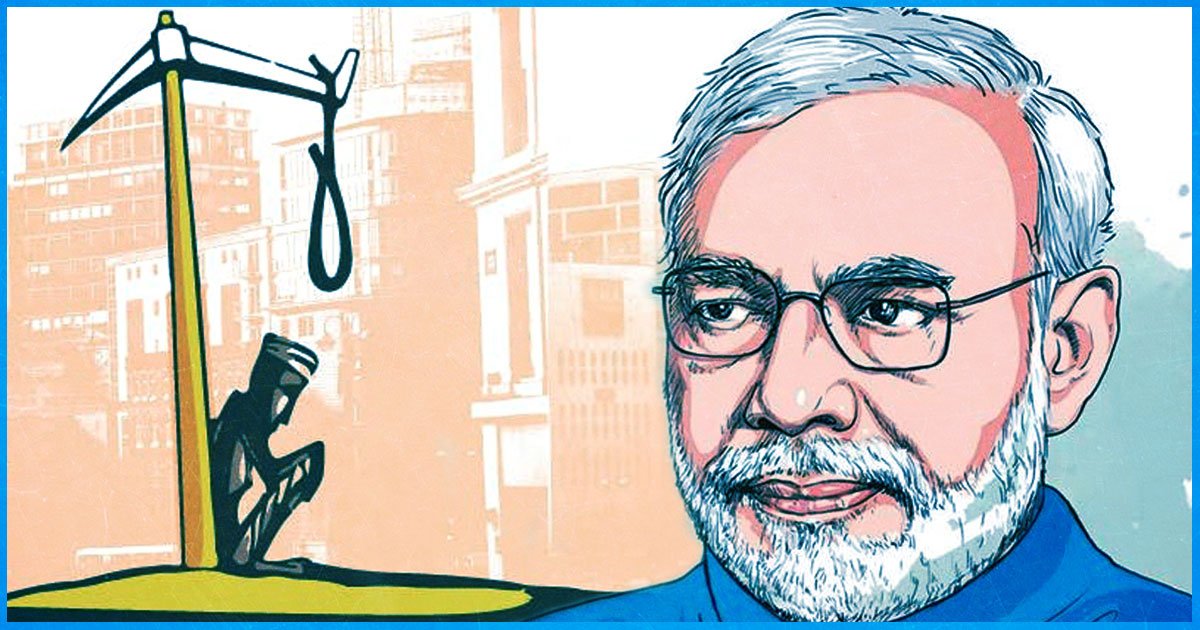
Maharashtra Farmer Commits Suicide Due To Mounting Debt, Mentions PM Modi In Suicide Note
13 April 2018 6:45 AM GMT
“I am committing suicide because I have huge debt burden. The cotton crop in my farm was damaged this year due to the pink worm. Narendra Modi is responsible for my death.”
These are lines from a suicide note left behind by Shankar Bhaurao Chayanne, a farmer from Yavatmal, Maharashtra who took his own life by consuming poison.
According to The Indian Express, Devanand Pawar, head of the farmer’s committee for justice, led local villagers along with Chayare’s family to Gitanjali police station to register an FIR against Prime Minister Modi. This is the second incident in eight months at Yavatmal where a farmer killed himself and blamed Prime Minister Modi.
Earlier, when farmer Prakash Mangoankar had killed himself, the state government announced compensation for his family. However, according to Pawar, they are yet to receive any help. Pawar also feels that the current government is very insensitive towards farmers and is hell-bent on destroying them.
These are not the only incident, nor are they confined to Maharashtra. According to latest reports Published in The Times of India, there are over 12,000 farmers committing suicide every year.
According to the statistics given by the Centre, a total of 12,602 persons involved in the farming sector — 8,007 farmers-cultivators and 4,595 agricultural labourers – committed suicide during 2015, accounting for 9.4% of total suicide victims (133,623) in the country. Maharashtra, with 4,291 suicides, tops the list, followed by Karnataka – 1,569, Telangana – 1,400, Madhya Pradesh – 1,290, Chhattisgarh – 954, Andhra Pradesh – 916 and Tamil Nadu – 606. Together, 87.5% of the total farmer’s suicide are accounted in these seven states. The primary reason of half of the suicides in the country is ‘debt burden’.
According to an India Spend analysis of various government data in 2017, “70% of India’s 90 million agricultural households spend more than they earn on average each month resulting in mounting debt. Andhra Pradesh has the highest share of indebted agricultural households (93%), followed by Telangana (89%) and Tamil Nadu (82.1%). Another notable reason for the ever-increasing farmer’s debt is the rising healthcare cost. Outstanding loans for health reasons have doubled from 3% in 2002 to 6% in 2012, according to a 2015 analysis of NSSO data by the National Bank for Agriculture and Rural Development (NABARD)”.
What has the government done to improve the situation of farmers and the farming community? During his 2016 Budget speech, Finance Minister Arun Jaitley swore to double farmers income by 2022. He claimed the government would reorient its interventions in the farm and non-farm sectors for this purpose. Following this, the Union Minister for Human Resource Development Prakash Javadekar outlined a seven-point strategy to double farm income, which included measures to step up irrigation, provide better quality seeds and prevent post-harvest losses.
Uttar Pradesh and Maharashtra wrote off loans worth Rs 36,359 crore and Rs 30,000 crore, respectively. India faces a cumulative loan waiver of Rs 3.1 lakh crore ($49.1 billion) or 2.6% of the country’s gross domestic product in 2016-17.
Not surprisingly, we have seen a surge in farmer protests across the country. Most recently, thousands of protesters, including children, women and the elderly, had converged in Mumbai, after walking 180 from Nashik district, led by a national farmers’ organisation affiliated to the Communist Party of India (Marxist). These protesters demanded the government to do something more than just loan waiver. Since the government sets prices for farming in India and procures crops from farmers to incentivise production and ensure income support, they demanded to be paid at least one-and-a-half times the cost of their crops. They also wanted tribal farmers, who mainly cultivate in forests, to be allowed to own land. Farmers had said the government was yet to implement the waiver it had promised them last year.
The Logical Indian take
What are the main issues faced by a farmer? High cost of labour, agriculture equipment, seeds, chemicals, water crisis, interstate water disputes, lack of awareness, lack of direct integration with the market and climate change. While loan waiver is only one part of the solution, it is high time both the government and private sectors come up with a multi-pronged solution that addresses all of these issues and finds a sustainable solution for our farming community – the backbone of our nation.
 All section
All section













